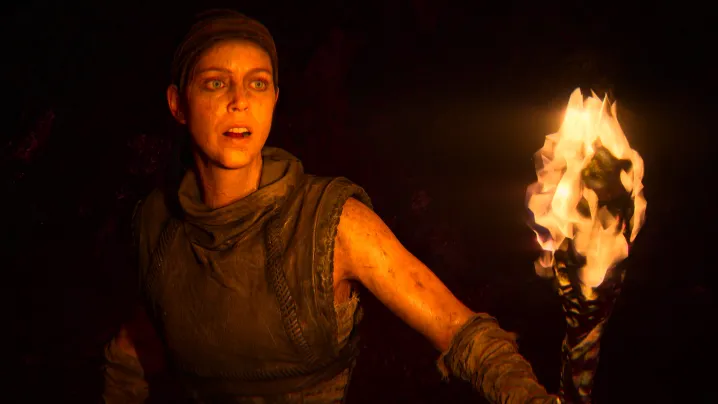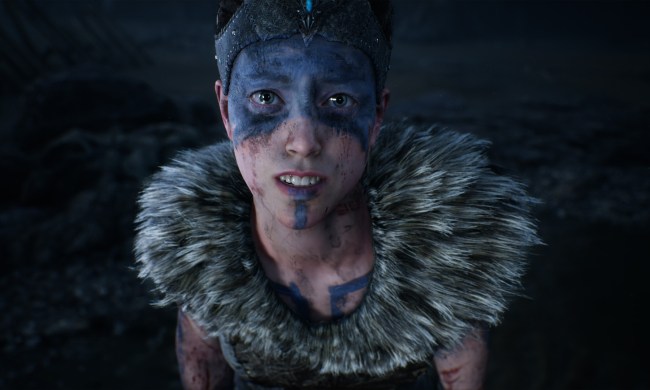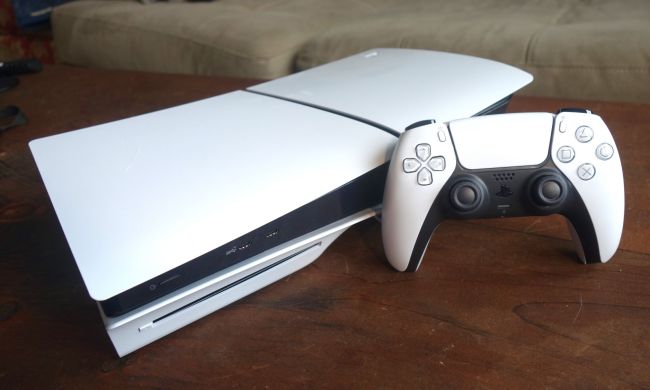
Out of all the photorealistic visuals in Senua’s Saga: Hellblade 2, there’s one that genuinely left my jaw hanging. It’s a simple shot. Deep in the sequel’s back half, I find myself trotting up a hill toward an enormous tornado. While I’d seen plenty of detailed images throughout my adventure, those few seconds made me feel like I was watching real footage, not an intricate animation. I watched in awe as a fierce storm whirred, debris flying in the distance as Senua’s rough skin was dimly illuminated by the cloudy skies above.
Minutes later, my eyes were glazing over again as I ran through yet another rocky landscape.
In some ways, Hellblade 2 feels like the culmination of decades of video game history. Since the medium’s inception, there’s been a drive to push graphics as far as they could go. That began as a practical experiment, as early games struggled to fully communicate images through rudimentary shapes. In more recent decades, it’s become something of an arms race to see who can craft the most detailed, realistic visuals possible. That’s been fueled by the PlayStation 5 and Xbox Series X, both of which have struggled to land games that fully reach the impressive tech’s potential.
Hellblade 2 is the first game of this console generation that truly feels like it capitalizes on what the Xbox Series X is capable of. It’s the end of a Sisyphean task, reaching the zenith of realistic visuals — at least for now. While that should be a cause for celebration, Hellblade 2’s polarizing reception isn’t exactly triumphant. While its tech has impressed across the board, mixed reactions to its comparatively thin gameplay serve as a reminder that the hunt for high graphical fidelity and realism might be a distracting cause in 2024. Studios like Ninja Theory aren’t pushing a boulder up a mountain anymore; they’re rolling it on a treadmill.
The endless climb
In the long years leading up to Hellblade 2’s release, developer Ninja Theory put its technical prowess front and center. While the game would no-show at Xbox’s 2021 games showcase, it got a short segment during an “Extended” show later in the week. The three-minute segment would offer a montage detailing the tech being used to create the adventure. From that moment, it was clear that Hellblade 2 was being positioned as a showpiece for the Xbox Series X. It would be the kind of graphical showstopper that usually launches with a console … though it didn’t launch until the presumed midpoint of the console’s life.
Three years after that presentation, Hellblade 2 is here, and it’s undeniably the most impressive technical feat of this console generation. Senua looks photorealistic thanks to advanced motion capture and animation innovations. Every landscape looks like a photograph, loaded with detailed rocks and twisted forests bathed in warm daylight. In one sequence, Senua tosses a flaming spear at a giant. Its body lights up with fire that almost looks like it were filmed and superimposed over the monster. Every frame is a cinematic spectacle.
But spectacle only goes so far in games, and that’s a hard truth that Hellblade 2 is now facing at its polarizing release. Initial reviews were torn on the project. While some critics hailed it as an astonishing narrative triumph, others weren’t so impressed. Middling reviews from the likes of GameSpot and The Washington Post praised its visuals, but were more concerned with its lack of engaging gameplay. Much of the adventure has players simply running around gorgeous environments, solving similar symbol-matching puzzles, and fighting through repetitive one-on-one battle gauntlets. It may be the most realistic looking game of all time, but that may be a hollow victory for Xbox at the moment.
The reaction to Hellblade 2 dredges up a question that’s been debated for decades: Do incredible graphics really matter anymore?

That question begs for a nuanced answer. “Graphics” is a catch-all term that encapsulates a lot of important pieces of game creation. Art style, fidelity, animation, and more all tend to get lumped into that bucket. In that sense, yes, graphics will always be an important piece of the puzzle. Visuals communicate ideas, just as a script does. Last year’s El Paso, Elsewhere uses rough, jarring visuals to sell the uneasy nature of its twisted world. Hellblade 2, on the other hand, wants to put players in its hero’s head as it speaks about the very real mental health issue she faces. Hyper realistic visuals are crucial to putting players in Senua’s shoes.
But Hellblade 2 proves that jaw-dropping visuals aren’t always enough to wow players. That needs to be paired with engaging gameplay that works in tandem with those images to push ideas. That doesn’t mean that every game needs to be as complex as a God of War. Heck, a video game doesn’t even need to be traditionally fun. What’s important is that the gameplay feels meaningful — and that’s where Hellblade 2 is hitting a wall with some players. Unlike its subversive predecessor, a game filled with antagonistic design choices that mirror Senua’s mental state, Hellblade 2 prioritizes seamless gameplay over meaningful friction. The result is a cinematic experience that feels oddly smooth considering its rough subject matter. The stakes are low. While the first Hellblade put players on edge with a fake “permadeath” system, a death here results in an instant respawn. The paranoia and anxiety is gone, creating a very different emotional journey.
Playing it, I can’t help but feel Ninja Theory sacrificed its best gameplay ideas in service of technological showmanship. That’s most apparent in its approach to combat. The first Hellblade is infamous for its messy, but effective, battles. Senua often finds herself surrounded by enemies, which can be a struggle to keep track of as the voices in her head mess with players’ sense of direction. It’s frustrating, but helps build a disorienting feeling that’s crucial to understanding Senua’s struggle. Hellblade 2 removes that friction in favor of tightly choreographed and animated battles that look like a playable movie. They’re visceral sequences at first, but the charm wears off as it repeats the same shiny trick over and over.
At a certain point, who really cares how good it all looks?
Diminishing returns
Hellblade 2’s surprising reception comes at a critical moment for console makers like Sony and Microsoft. Now four years in, the PS5 and Xbox Series X generation is beginning to feel like a bust. Both consoles put a major focus on their show-stopping power, but they’ve struggled to deliver that promise consistently. Cross-generational support has held back games like God of War Ragnarok, while a lot of major first-party games struggle to balance performance and fidelity. Hellblade 2 at last delivers on the lofty promises of the console makers (minus its limited performance), but it doesn’t seem like it’ll be remembered as a generation-defining game.
It feels as though we’ve finally reached a breaking point in the endless hunt for realism. The returns for games as obsessively crafted as Hellblade 2 are diminishing. It makes for a great back-of-the-box feature and will undoubtedly net it some awards at the end of the year, but the impressed reactions are bound to be short-lived. The sequel is more likely to be remembered (or forgotten) for its limited interactivity, while its predecessor’s “permadeath” bluff and gripping story will forever live in infamy.

When I reflect on that dynamic, I think back on Hellblade 2’s launch day. While the sequel was supposed to be May’s big game release, it was quickly overshadowed as reviews for Paper Mario: The Thousand-Year Door, Nintendo’s remake of a GameCube classic, poured in. Glowing critiques praised its memorable writing and excellent RPG systems that still feel fresh 20 years later. They painted a picture of a truly timeless adventure that’s stood the test of time with ease. And it did that with paper visuals. You couldn’t ask for a starker contrast.
None of this means that console makers should stop upgrading their hardware or that developers should stop chasing highly detailed realism. Tech is a creative tool like anything else, and the further we push it, the more colors game creators can paint with. But that’s just one tool. Without thoughtful game design to put those amazing visuals to good use, that’s a lot of effort to expend reaching for a bar that will only rise when grabbed.



